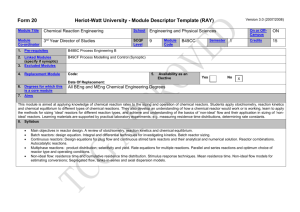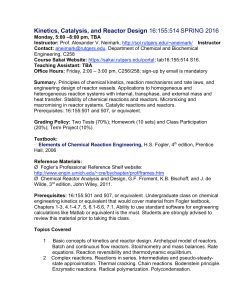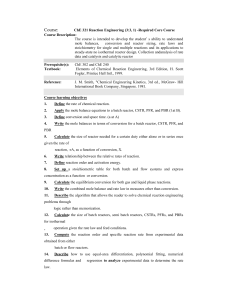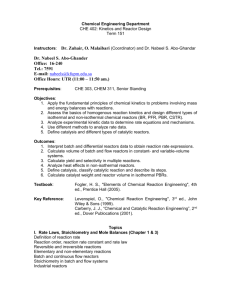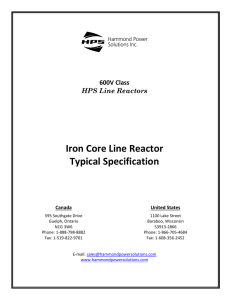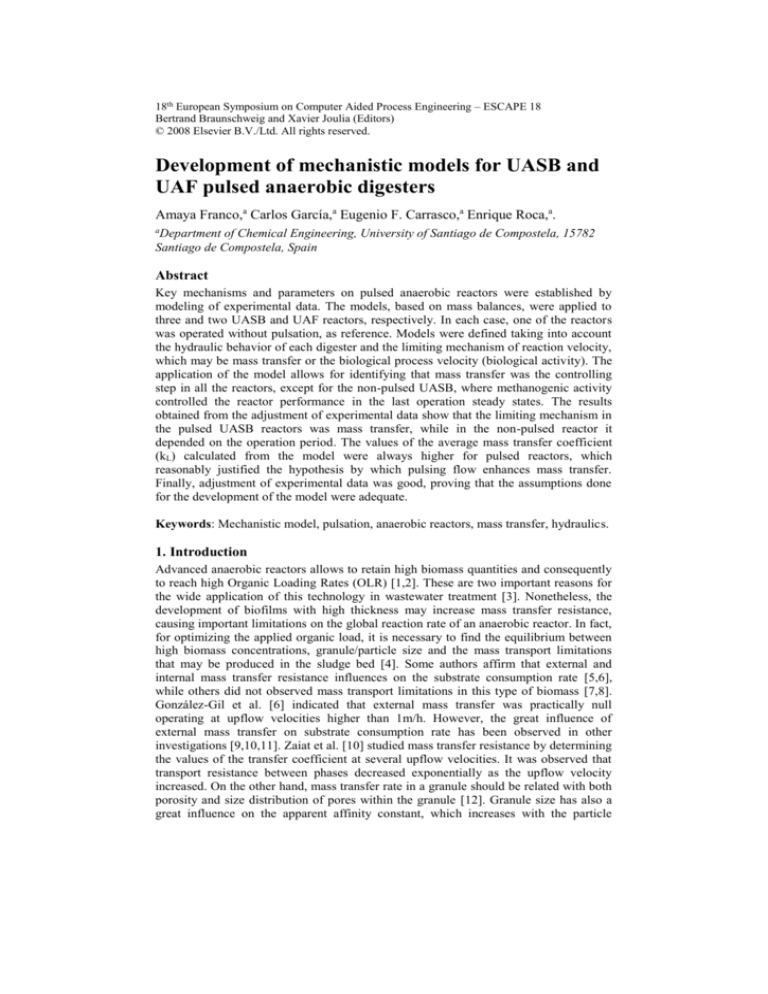
18th European Symposium on Computer Aided Process Engineering – ESCAPE 18
Bertrand Braunschweig and Xavier Joulia (Editors)
© 2008 Elsevier B.V./Ltd. All rights reserved.
Development of mechanistic models for UASB and
UAF pulsed anaerobic digesters
Amaya Franco,a Carlos García,a Eugenio F. Carrasco,a Enrique Roca,a.
a
Department of Chemical Engineering, University of Santiago de Compostela, 15782
Santiago de Compostela, Spain
Abstract
Key mechanisms and parameters on pulsed anaerobic reactors were established by
modeling of experimental data. The models, based on mass balances, were applied to
three and two UASB and UAF reactors, respectively. In each case, one of the reactors
was operated without pulsation, as reference. Models were defined taking into account
the hydraulic behavior of each digester and the limiting mechanism of reaction velocity,
which may be mass transfer or the biological process velocity (biological activity). The
application of the model allows for identifying that mass transfer was the controlling
step in all the reactors, except for the non-pulsed UASB, where methanogenic activity
controlled the reactor performance in the last operation steady states. The results
obtained from the adjustment of experimental data show that the limiting mechanism in
the pulsed UASB reactors was mass transfer, while in the non-pulsed reactor it
depended on the operation period. The values of the average mass transfer coefficient
(kL) calculated from the model were always higher for pulsed reactors, which
reasonably justified the hypothesis by which pulsing flow enhances mass transfer.
Finally, adjustment of experimental data was good, proving that the assumptions done
for the development of the model were adequate.
Keywords: Mechanistic model, pulsation, anaerobic reactors, mass transfer, hydraulics.
1. Introduction
Advanced anaerobic reactors allows to retain high biomass quantities and consequently
to reach high Organic Loading Rates (OLR) [1,2]. These are two important reasons for
the wide application of this technology in wastewater treatment [3]. Nonetheless, the
development of biofilms with high thickness may increase mass transfer resistance,
causing important limitations on the global reaction rate of an anaerobic reactor. In fact,
for optimizing the applied organic load, it is necessary to find the equilibrium between
high biomass concentrations, granule/particle size and the mass transport limitations
that may be produced in the sludge bed [4]. Some authors affirm that external and
internal mass transfer resistance influences on the substrate consumption rate [5,6],
while others did not observed mass transport limitations in this type of biomass [7,8].
González-Gil et al. [6] indicated that external mass transfer was practically null
operating at upflow velocities higher than 1m/h. However, the great influence of
external mass transfer on substrate consumption rate has been observed in other
investigations [9,10,11]. Zaiat et al. [10] studied mass transfer resistance by determining
the values of the transfer coefficient at several upflow velocities. It was observed that
transport resistance between phases decreased exponentially as the upflow velocity
increased. On the other hand, mass transfer rate in a granule should be related with both
porosity and size distribution of pores within the granule [12]. Granule size has also a
great influence on the apparent affinity constant, which increases with the particle
2
A. Franco et al.
diameter [6]. These results indicated the existence of mass transfer limitations in
anaerobic granules and corroborated the results obtained by other authors [5, 13].
Nevertheless, other studies have leaded to opposite results [12,14]. The abovementioned studies confirm that mass transfer limitations may exist in anaerobic
biofilms. However, this process will only be the limiting step when: (a) substrate
concentration in the reactor is low, (b) the percentage of granules with an average
diameter > 1 mm is high, and (c) methanogenic activity of biomass is high, since the
normal value varies between 0.4 and 0.6 kg COD/kg VSS·d [15]. Pulsing flow has been
applied to a great number of chemical [16,17] and biochemical processes [18,19,20] for
improving mass transfer, biomass properties and efficiency of the equipment employed.
The objective of the present work is the development of mechanistic models, for
studying the role that pulsation plays on the enhancement of bioreactor performance.
Model parameters support the hypothesis that mechanical effect of pulsation can be
responsible of the improvement of efficacy in Upflow Anaerobic Sludge Blanket
(UASB) reactors and Upflow Anaerobic Filters (AF).
2. Materials and methods
Experimental data of the operation and hydraulic behavior of UASB [19] and UAF [20]
reactors were employed for the development and validation of mechanistic models. The
models were applied to three UASB reactors (two pulsed P1 and P2, and one nonpulsed NP) and two UAF (one pulsed P and other non-pulsed NP). Pulsing flow was
produced by an Elastic Membrane Pulsator [21], placed in the bottom part of reactors
P1, P2 and P. Pulsation in reactor P1 was generated by pulsing simultaneously the
feeding and the recycling flow, while in reactors P2 and P, only the feeding flow was
pulsed, since they were operated without recirculation. This difference conditioned not
only the frequency and the amplitude of pulsation, but also the upflow velocity of each
reactor [19,20]. The only configuration difference between UASB and UAF reactors
was that UAF reactors were filled with 120 corrugated PVC Raschig rings of 12 mm in
size, decreasing their total volume from 0.80 to 0.76 L. The inoculum of both UASB
and UAF reactors came from a hybrid UASB-UAF reactor treating dextrose, although it
was collected in different times. In case of the UASB reactors, the inoculated biomass
was in granular form and with a specific methanogenic activity (SMA) of 0.27 kg CH4COD/kg VSS·d, while for UAF reactors, the sludge was flocculent, with a SMA of 0.2
kg COD CH4/kg VSS·d. The final Volatile Suspended Solids (VSS) concentration in
each reactor was around 14-15 g/l.
3. Model development and description
The developed models are based on mass balances. For establishing these balances, the
hydraulic behavior, determined from Residence Time Distribution (RTD) curves, and
the limiting mechanism of the apparent reaction rate were considered. This latter may be
due to mass transfer between phases or to the biological reaction rate.
The following theoretical and practical approaches and simplifications were taken into
account for model development: 1) Biochemical reaction limiting stage of anaerobic
degradation is always methanogenesis; 2) Spherical geometry was considered for
biocatalyst constituting the sludge bed 3) The liquid-solid interphase thickness is very
small and almost constant value for the upflow velocity; 4) Growing of biomass within
the reactor is exponential, assuming unlimited substrate availability; 5) The substrate
concentration within the particles/granules is negligible with respect to the
concentration in the outer layer; 6) The sludge bed keeps constant its geometry during
Development of mechanistic models for UASB and UAF pulsed anarobix digesters
3
the whole non pulsed operation; 7) The variation of the SMA with time is calculated by
functions established from experimental data.
3.1. Modeling of UASB and UAF reactors
A substrate (COD) mass balance applied to UASB and UAF is described by Equation 1.
ra Q0 S 0 Qr S f Q0 Qr S f
(1)
3
where S0 is the substrate concentration (kg COD/m ) in the influent, Q0 is the feeding
flowrate (m3/d), Qr is the recycling flowrate (m3/d), Sf is the substrate concentration (kg
COD/m3) in the effluent (and in reactor for perfect mixing behavior) and ra is the
apparent substrate consumption rate (kg COD/d). In order to better understand the
different observed behavior of all reactors, a mathematical model taking into account
the different aspects (kinetics, external mass transfer and hydraulics) was developed.
3.1.1. Apparent kinetics.
The apparent substrate consumption rate (ra) may be due to two different mechanisms.
One of them would be the biological reaction rate of methanogenic bacteria (the slowest
phase of the whole anaerobic degradation process and therefore conditioning the overall
rate), because the substrate employed (dextrose) for feeding the reactors was not
complex and only acidogenesis and methanogenesis were involved in its degradation.
The biological reaction rate (ra) can be calculated from SMA measures and from the
kinetics of bacterial growth. Once ra is known, the final substrate concentration is
calculated from Equation 2:
Q S r
(2)
Sf 0 0 a
Q0
3.1.2. External mass transfer.
Mass transfer from the liquid to the granules was considered as another limiting step.
Granules are the responsible for the substrate transformation into biogas (mainly CH4
and CO2). Considering a steady state approach for the biocatalyst, all the substrate
(COD) that reaches the biocatalyst particles is transformed and thus no accumulation
exists in the surface/liquid interface. As it was shown above, apparent kinetics of
biocatalyst was used which represent the join contribution of internal mass transfer and
biochemical reaction kinetics. Complete mixed flow behavior is also considered as a
good approximation, thus bulk substrate concentration is considered homogeneous in
the whole reactor and equal to concentration in the outlet stream. In this case, the
apparent reaction rate is calculated by the expression described in Equation 3:
(3)
ra k L AS f
where kL is the mass transfer coefficient referred to the outer granule surface (m/d), and
A is the liquid/granule area of mass exchange (m2). Then, the final substrate
concentration Sf in the reactors is calculated by the equation:
Q0 S 0
(4)
Sf
Q0 k L A
3.1.3. Hydraulics.
Hydraulic behaviour determined from RTD curves [19,20] indicated that UASB NP
reactor is very close to a CSTR (Continuous Stirred Tank Reactor), while UASB P1 and
UASB P2 pulsed reactors behaved like 1.26 and 1.9 CSTR in series, respectively, while
UAF NP and UAF P2 reactors behaved like 1.7 and 2.21 CSTR in series, respectively.
According to this, UASB and UAF reactors were divided in two compartments (zones 1
and 2), except reactor UASB NP, which was not divided, and reactor UAF P2, which
was divided in three compartments. If the limiting mechanism in the reactors is
biological reaction then the mass balance would be that described by Equation 2,
4
A. Franco et al.
applied to each zone. If mass transfer rules the apparent substrate consumption rate then
the mass balance in the zone 1 of reactors with recycling flow (UASB P1 and UAF NP)
is described by the following expression:
Q0 S 0 Q r S f
(5)
Sa
kL A
Q0 Q r
N
Sa is the substrate concentration at the outlet of zone 1. The exchange area of zone 1
must be the total exchange area divided by N (N is the number of ideal CSTR obtained
from RTD curves.). A uniform particle distribution size in the whole reactor is assumed.
A global mass balance in the reactors is obtained by replacing Sa value in Equation 6:
Q0 Qr Q0 S0 Qr S f
(6)
Sf
k L A
kL A
( N 1)
Q0 Qr
Q0 Qr
N
N
3.2. Model parameters
Parameters involved in the mass balance were calculated from experimental data of
each reactor [19,20]. The useful volume (V) was determined from RTD assays
employing Dextran Blue and LiCl as tracers. The average diameter of granules was
determined by doing a weighted mean of particle size distribution data. However, in
UAF reactors, a mixture of granular and flocculent sludge was present. Thus, the
average particle diameter has not been experimental determined because the difficulty
of measuring the diameter of flocculent particles. Average diameter of this kind of
particles was supposed uniform and equal to 0.12 mm [22]. On the other hand, the
average diameter of granular particles can be considered similar to that obtained for
UASB reactors. The number and the total area of particles (granules) in both UASB and
UAF reactors are calculated assuming a spherical geometry.
3.3. Calculation procedure of the model
Mathematical models developed were implemented in Matlab® and run iteratively.
Firstly, model simulation for determining the control mechanism of the process was
carried out for each reactor using the different steady state data. Two mechanisms were
considered for modeling the behavior of the process: external mass transfer rate and
biochemical reaction kinetic. To establish the controlling mechanism, the final substrate
concentration was computed through the mass balance equations (Eq. 1 - 6), proposed
for each reactor configuration. With the model considering external mass transfer, an
iterative procedure was necessary for obtaining the kL value, later kL values are checked
for order of magnitude consistency. Subsequently, the model was adjusted for the
calculation of the mass transfer coefficient (kL) or the biological reaction rate,
depending of the mechanism controlling the overall rate of the process. Once these
parameters were calculated, a simulation was performed to check the correct adjustment
of the previous simulation, and to obtain the definitive results. Data for five steady state
periods in UASB and UAF reactors were employed as model input. Standard deviation
lower than 2 for the OLR (kg COD/m3·d) and than 4 for the % COD removal was
considered as criteria for selecting the steady states periods.
4. Model application
Data from steady states were fitted by the proposed models to study the mechanical
effect of pulsation on improving mass transfer with respect to the non-pulsed UASB and
UAF reactors. The calculation algorithm compares the result of a kinetic reaction
mechanism against mass transfer limitation mechanism. In the case of the mechanism
Development of mechanistic models for UASB and UAF pulsed anarobix digesters
5
based on a mass transfer limitation, the calculation of the mass transfer coefficients
requires an iterative search. This search requires obtaining an adequate order of
magnitude for the mass transfer coefficients. In literature, the kL values present, for the
operating conditions of the experiments, an order of magnitude 10-3 [23]. Moreover,
empirical correlations [23] were used for checking the consistency of the kL values. As
example, a mass transfer coefficient of 1.89∙10 -3 m/d was obtained after an iterative
calculation for the P2 UAF reactor using data of the second steady state (see Figure 2)
conditions (organic loading rate of 4.34 kg COD/m3.d; 98 % of organic matter removal;
0.27 gCOD/gSSV.d of SMA; 0.15 of void volume fraction; 1∙10-3 of particle diameter;
and a feed flowrate of 5.67∙10-4 m3/d). The value of the final substrate concentration
obtained by mass transfer model was 102.33 g/m3 greater than the obtained by the
kinetic model. Therefore, it can be said that in this case external mass transfer is the
controlling mechanism.
The controlling mechanism in the two first periods for the non-pulsed UASB was mass
transfer. The biological reaction rate controlled the remaining ones. The value of the
mass transfer coefficient (kL) was calculated with Equation 4 and using experimental
data of COD removal.
100
P2
P1
98
%COD Removal
96
94
92
90
88
86
84
82
80
10-20
42-46
56-65
days
81-94
109-123
10-20
42-46
56-65
days
81-94
Model
109-123
Experimental
100
NP
%COD Removal
95
90
85
80
75
70
65
60
10-20
42-46
56-65
days
81-94
109-123
Figure 1. Steady state experimental data for NP, P1 and P2 UASB reactors fitted by the model.
Mass transfer was the kinetic limiting mechanism in the pulsed reactors (P1 and P2) for
all the steady states analyzed. kL values for each reactor were calculated employing
Equation 6, in a similar way as for NP reactor. Once the mass transfer coefficients or the
reaction rate (depending on the limiting mechanism) were calculated in each reactor, the
goodness of the model for fitting the experimental data was evaluated. Figure 1 shows
the experimental percentage of COD removal (plus standard deviation) and that
estimated by the model. The model reproduces quite well the behavior of the three
UASB reactors, so that the selection of limiting mechanisms indicated by the model was
adequate. In reactor NP, mass transfer was the limiting mechanism in the first 46 days
of operation, which agrees with experimental data, since the removal efficiency in this
period was high and the reactor did not show any limitations in the biological reaction
rate. In the following periods, the reactor performance was not good, achieving poor
removal efficiencies, although the applied load was not very high. SMA decreased
6
A. Franco et al.
progressively, as it is also explained by the model. The biological reaction rate was the
limiting mechanism in these periods. In pulsed reactors, the limiting mechanism was
mass transfer rate. In these reactors, the operation was stable, presenting both good
removal efficiency and a high methanogenic activity.
UAF reactors. The limiting mechanism in all the steady state periods for both NP and
P2 UAF was mass transfer. Model results agree quite well with the operation data. The
operation efficacy of these reactors was good during the whole experimentation,
especially for reactor P2, which achieved higher removal efficiencies at higher loads
than in reactor NP. The kL coefficients were estimated using Equation 6 (with and
without recycling), and then, the experimental data was fitted by the model. Once again,
and as it can be seen in Figure 2, the fit goodness is very high for the two reactors in all
the steady state periods. The model explains well enough the reactor performance.
100
P2
NP
%COD Removal
95
90
85
80
75
70
9-15
30-45
50-70
days
70-90
104-118
9-15
30-45
50-70
days
70-90
Model
104-118
Experimental
Figure 2. Experimental data of NP and P2 UAF reactors fitted by the model.
5. Conclusions
Mechanistic model indicated that mass transfer controlled in most occasions the
performance of the studied reactors. The reason can vary in each case and it depended
of biomass characteristics, reactor type, configuration and hydraulics. kL values on the
pulsed UAF reactor were more than twice higher than in the NP, this proving that
mechanical effect of pulsation decreases mass transfer limitations. There were not
significant differences between kL coefficients for pulsed and non-pulsed UASB
reactors. Thus mass transfer resistance became the limiting mechanism due to its
relative high value compared to the high activity of the sludge bed granules in pulsed
reactors.
References
[1] J.C. Young and B.S. Yang, J. Water Pollut. Con. F., 61 (1989) 1576.
[2] G. Lettinga, A.F. van Velsen, S.W. Hobma, W. de Zeeuw and A. Klapwyk, Biotechnol.
Bioeng., 22 (1980) 699.
[3] R.J. Frankin, Water Sci. Technol., 44 (2001) 1.
[4] A. Grobicki and D.C. Stuckey, Biotechnol. Bioeng., 37 (1990) 344.
[5] J. Dolfing, Appl. Microbiol. Biot., 22 (1985) 77.
[6] G. González-Gil, L. Seghezzo, G. Lettinga and R. Kleerebezem, Biotechnol. Bioeng., 73
(2001) 125.
[7] J.E. Schmidt and B.K. Ahring, Appl. Microbiol. Biot., 35 (1991) 681.
[8] D. de Beer, J.W. Huisman, J.C. van den Heuvel and S.P.P. Ottengraf, Water Res., 26 (1992)
1329.
[9] M.T. Kato, J.A. Field, P. Versteeg and G. Lettinga, Biotechnol. Bioeng., 44 (1994) 469.
[10] M. Zaiat, L.G.T. Vieira and E. Foresti, Biotechnol. Tech., 10 (1996) 121.
[11] S.V. Mohan, V.L. Babu, Y.V. Bhaskar and P.N. Sarma, Bioresource Technol., 98 (2007)
1373.
Development of mechanistic models for UASB and UAF pulsed anarobix digesters
[12] P.A. Alphenaar, M.C. Pérez, W.J.H. van Berkel and G. Lettinga, Appl. Microbiol. Biot., 36
(1992) 795.
[13] S. Fukuzaki, N. Nishio and S. Nagai, J. Ferment. Bioeng., 72 (1991) 405.
[14] P.A. Alphenaar, M.C. Pérez and G. Lettinga, Appl. Microbiol. Biot., 39 (1993) 276.
[15] J.E. Schmidt and B.K. Ahring, Biotechnol. Bioeng., 49 (1996) 226.
[16] Y. Lemay, G. Pineault and J.A. Ruether, Ind. Eng. Chem. Proc. D. D., 14 (1975) 280.
[17] J.G. Boelhouwer, H.W. Piepers and A.A.H. Drinkenburg, Chem. Eng. Sci., 56 (2001) 1181.
[18] T. Murakami, J. Usui, K. Takamura and T. Yoshikawa, Water Sci. Technol., 41 (2000) 295.
[19] A. Franco, E. Roca and J.M. Lema, Water Sci. Technol., 48 (2003) 51.
[20] A. Franco, E. Roca and J.M. Lema, J. Environ. Eng., 133 (2007) 186.
[21] J.M. Lema, M.J. Núñez, A. Sanromán and E. Roca, Spanish Patent 2059228, 1995.
[22] C.P. Chu, D.G. Tsai, D.J. Lee and J.H. Tay, J. Environ. Manag., 76 (2005) 239.
[23] .R.H.Perry, C.C. Chilton (1985) Chemical Engineers Handbook. New York: McGraw–Hill.
7

